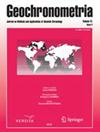Assessing the maximum limit of SAR-OSL dating using quartz of different grain sizes
IF 0.9
4区 地球科学
Q3 Earth and Planetary Sciences
引用次数: 18
Abstract
Abstract SAR-OSL dating studies of Romanian, Serbian and Chinese loess using fine and coarse quartz have previously resulted in a series of controversial issues. We extend here the investigations using fine (4–11 μm) and different coarse quartz (>63 μm) grains extracted from aeolianites from a site on Eivissa Island (southwestern Mediterranean). Aeolianites were chosen since they contain quartz from a different geological context and have significantly lower environmental dose rates. The dose response curves of the OSL signals for fine and coarse quartz are similar to those for loess and are also represented by the sum of two saturating exponential functions. For doses up to ~200 Gy, the dose response curves of fine and coarse grains from aeolianites can be superimposed and the ages obtained for the different grain sizes are in agreement up to ~250 ka, increasing our confidence in the accuracy of the ages obtained for samples with such doses, irrespective of the magnitude of the environmental dose rate. Particularly for the fine quartz fraction, a mismatch between the SAR dose response curve and the dose response curve obtained when doses are added to the natural is reported, indicating that the application of the SAR protocol in the high dose range is problematic. This dose dependent deviation is much less pronounced for coarse grains. Thus, it seems reasonable to infer that the dose response curves for the coarse grains, although saturating earlier can be regarded as more reliable for equivalent dose calculation than those for the fine grains.利用不同粒度的石英评估SAR-OSL定年的最大限度
利用细石英和粗石英对罗马尼亚、塞尔维亚和中国黄土进行SAR-OSL定年研究,曾引起一系列争议。本文采用从地中海西南部Eivissa岛的风成岩中提取的细石英(4-11 μm)和不同粗石英(> - 63 μm)颗粒进行扩展研究。之所以选择风成岩,是因为它们含有来自不同地质环境的石英,环境剂量率明显较低。细石英和粗石英的OSL信号的剂量响应曲线与黄土的相似,也用两个饱和指数函数的和来表示。对于~200 Gy的剂量,风成岩细粒和粗粒的剂量响应曲线可以叠加,不同粒径的年龄在~250 ka范围内是一致的,这增加了我们对这种剂量下样品年龄的准确性的信心,而不考虑环境剂量率的大小。特别是对于细石英组分,有报道称SAR剂量响应曲线与向天然组分中添加剂量时得到的剂量响应曲线不匹配,这表明在高剂量范围内应用SAR方案存在问题。对于粗粮,这种剂量依赖性偏差就不那么明显了。因此,我们似乎可以合理地推断,虽然较早饱和的粗颗粒的剂量响应曲线比细颗粒的剂量响应曲线更可靠地用于等效剂量的计算。
本文章由计算机程序翻译,如有差异,请以英文原文为准。
求助全文
约1分钟内获得全文
求助全文
来源期刊

Geochronometria
地学-地球科学综合
CiteScore
2.20
自引率
0.00%
发文量
1
审稿时长
>12 weeks
期刊介绍:
Geochronometria is aimed at integrating scientists developing different methods of absolute chronology and using them in different fields of earth and other natural sciences and archaeology. The methods in use are e.g. radiocarbon, stable isotopes, isotopes of natural decay series, optically stimulated luminescence, thermoluminescence, EPR/ESR, dendrochronology, varve chronology. The journal publishes papers that are devoted to developing the dating methods as well as studies concentrating on their applications in geology, palaeoclimatology, palaeobiology, palaeohydrology, geocgraphy and archaeology etc.
 求助内容:
求助内容: 应助结果提醒方式:
应助结果提醒方式:


